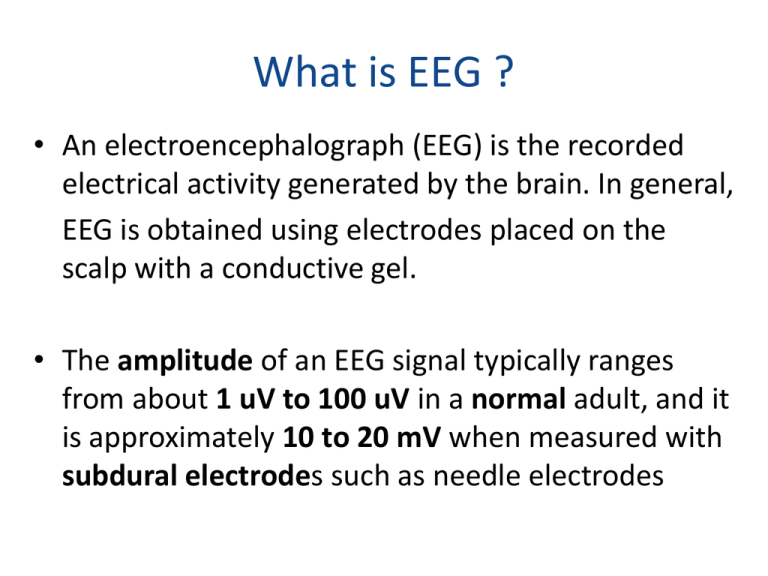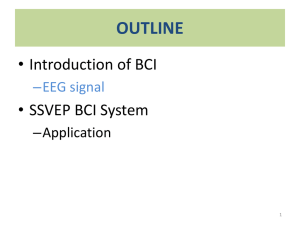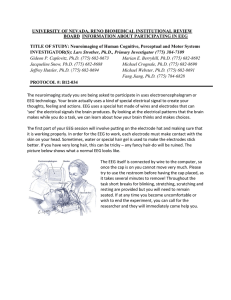What is EEG ?
advertisement

What is EEG ? • An electroencephalograph (EEG) is the recorded electrical activity generated by the brain. In general, EEG is obtained using electrodes placed on the scalp with a conductive gel. • The amplitude of an EEG signal typically ranges from about 1 uV to 100 uV in a normal adult, and it is approximately 10 to 20 mV when measured with subdural electrodes such as needle electrodes Electroencephalography (EEG) • • Measures the brain’s electric activity from the scalp Measured signal results from the activity of billions of neurons • • Amplitude: Bandwidth: • Errors: 0.001-0.01 mV 0.5-40 Hz – Thermal RF noise – 50/60 Hz power lines – Blink artifacts and similar • Typical applications: – Sleep studies – Seizure detection – Cortical mapping Different types of normal brain waves • Beta waves occur at a frequency of 13 to 30 cycles per second. They are usually associated with anxiety, depression, or the use of sedatives. • Alpha waves occur at a frequency of 8 to 12 cycles per second in a regular rhythm. They are present only when you are awake but have your eyes closed. Usually they disappear when you open your eyes or start mentally concentrating. • Theta waves occur at a frequency of 4 to 7 cycles per second. They are most common in children and young adults. • Delta waves occur at a frequency of 0.5 to 3.5 cycles per second. They generally occur only in young children during sleep. EEG measurement setup • 10-20 Lead system is most widely clinically accepted • Certain physiological features are used as reference points • Allow localization of diagnostic features in the vicinity of the electrode • Often a readily available wire or rubber mesh is used • Brain research utilizes even 256 or 512 channel EEG hats Electrodes – Basics • High-quality biopotential measurements require – Good amplifier design – Use of good electrodes and their proper placement on the patient – Good laboratory and clinical practices • Electrodes should be chosen according to the application • Basic electrode structure includes: – – – – – The body and casing Electrode made of high-conductivity material Wire connector Cavity or similar for electrolytic gel Adhesive rim • The complexity of electrode design often neglected Electrodes - Basics • • • • Skin preparation by abrasion or cleansing Placement close to the source being measured Placement above bony structures where there is less muscle mass Distinguishing features of different electrodes: – – – – How secure? The structure and the use of strong but less irritant adhesives How conductive? Use of noble metals vs. cheaper materials How prone to artifact? Use of low-junction-potential materials such as Ag-AgCl If electrolytic gel is used, how is it applied? High conductivity gels can help reduce the junction potentials and resistance but tend to be more allergenic or irritating Baseline drift due to the changes in junction potential or motion artifacts Choice of electrodes Electromagnetic interference Shielding Muscle signal interference Placement Ag-AgCl, Silver-Silver Chloride Electrodes • The most commonly used electrode type • Silver is interfaced with its salt silver-chloride • Choice of materials helps to reduce junction potentials – Junction potentials are the result of the dissimilar electrolytic interfaces • Electrolytic gel enhances conductivity and also reduces junction potentials – Typically based on sodium or potassium chloride, concentration in the order of 0.1 M weak enough to not irritate the skin • The gel is typically soaked into a foam pad or applied directly in a pocket produced by electrode housing • Relatively low-cost and general purpose electrode • Particularly suited for ambulatory or long term use Gold Electrodes • • • • Very high conductivity suitable for low-noise meas. Inertness suitable for reusable electrodes Body forms cavity which is filled with electrolytic gel Compared to Ag-AgCL: greater expense, higher junction potentials and motion artifacts • Often used in EEG, sometimes in EMG Conductive polymer electrodes • • • • • • Made out of material that is simultaneously conductive and adhesive Polymer is made conductive by adding monovalent metallic ions Aluminum foil allows contact to external instrumentation No need for gel or other adhesive substance High resistivity makes unsuitable for low-noise meas. Not as good connection as with traditional electrodes Metal or carbon electrodes • Other metals are seldom used as high-quality noble metal electrodes or low-cost carbon or polymeric electrodes are so readily available • Historical value. Bulky and awkward to use • Carbon electrodes have high resistivity and are noisier but they are also flexibleand reusable • Applications in electrical stimulation and impedance plethysmography Needle electrodes • • • • Obviously invasive electrodes Used when measurements have to be taken from the organ itself Small signals such as motor unit potentials can be measured Needle is often a steel wire with hooked tip Current technique of BCI Input Output 10 Based on EEG signal : 1. Event–related de-synchronization / synchronization (ERD/ERS) 2. Steady state visual evoke potentials (SSVEP) 3. P300 component of event related potentials (ERPs) 4. Slow cortical potentials (SCPs) 11 Different features of each BCI system [2] 12 SSVEP is an EEG signal response to the flickering visual stimulus with a frequency higher than 6 Hz [1] 13 Journal: Development of a Low-Cost FPGA-Based SSVEP BCI Multimedia Control System [1] • User target: patients suffering from severe motor disabilities, such as amyotrophic lateral scleroses (ALS), spino-cerebellar ataxia (SCA), and other paralyzed patients, may have limited motion while constrained on a hospital bed 14 System configuration 15 Acquisition module Pre amplifier: Instrumentation amplifier, INA 128, (Gain setting, Gain: 1000) 16 ADC Module MicroChip MCP3201 • the 8-pin dual in-line package (DIP) with serial control interface [serial peripheral interface (SPI)] devices,. • The resolution and maximum sampling rate of the ADC are 12 b and 100 k samples/s. 17 Signal Processing 18 Data flickering, segmenting and averaging 19 Hardware System 20


